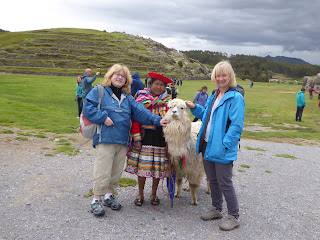The full team on board, after breakfast the six of us headed
out on a serious mission……..to find the artisan craft market in Cusco.
After 2 hours bartering and bargaining plus trying to figure out Peruvian currency after just getting the hang of Bolivian, we all headed back with a variety of interesting purchases…….now we just need to find a space in the luggage for them……
After 2 hours bartering and bargaining plus trying to figure out Peruvian currency after just getting the hang of Bolivian, we all headed back with a variety of interesting purchases…….now we just need to find a space in the luggage for them……
 |
| It'll look lovely in Glasgow... |
 |
| The Boys after 2 hours in the market..... |

The site was impressive with much of the original Inca stonework, terraces and a ceremonial bathing pool for the Inca King. It is thought this was a water temple but due to its location and workmanship, was one for the king and high nobility.
From there it was on to Sikllakancha where many of the
original brain surgery or trepanation was carried out. There is the operating
table where the operations were carried out. Eileen was having a busman’s
holiday at this point…..
One of the reasons they were early pioneers of this (although they reckon only 1/1000 survived) was that for high status families they bound the heads of children to give them longer and higher heads and this led to severe headaches and other issues.
 |
| The Operating table........ |
One of the reasons they were early pioneers of this (although they reckon only 1/1000 survived) was that for high status families they bound the heads of children to give them longer and higher heads and this led to severe headaches and other issues.
From there it was on to the major site of Sacsayhuaman. On the way in, Sheena and Eileen had their first Llama encounter....
As Cusco was the home of the Inca kings, this hilltop fortress was immense and one of the most important fortifications. The walls are immense. The main ramparts zigzag for 400m with huge stones fitted together perfectly, the largest is 8.5m high and 300 tonnes. The scale is just immense.
During construction over 10,000 workers were involved. This fortress and its final defeat was one of the most important battles in the downfall of the Inca empire to the Spanish conquistadores.
 |
| Largest stone 8.5m tall... |
First stop was the church of Santa Domingo. Not another
church we thought, but no it wasn’t !
As we had seen on every other location, the Spanish had
built crosses or religious sites on top of every important local worship site
but this was the most impressive. They had built a huge Franciscan church on
top of the biggest Sun Temple in the Inca capital !!
 |
| Sun Temple under the church |
This site Qorikancha was where the Inca kings were crowned
and the walls were originally covered in gold. Qori means gold and Kancha a
store, so its name meant the place that held the gold.
During two major earthquakes, the colonial construction had
come down and had to be rebuilt but the Inca walls never moved due to the
trapezoid shape and interlocking stones. All the local schoolchildren know that
if there is another earthquake head for an Inca wall and stand underneath it !
Our last stop today is the Catherdral in Cusco's Plaza des Armes, the main square.
Yes, another church….but again with an ulterior purpose. The local artisans had been used by the Spanish to complete the beautiful and ornate wood carvings for the altar and choir areas and to paint huge religious pictures for the walls. In subversive resistance, these artisans had introduced native elements surreptitiously into the designs. Condor wings replaced angel wings, sun representations instead of halos all very subtle and clever but obvious when you know what to look for. The best was the Last Supper painting which had Guinea Pig as the main dish !!! Guinea Pig is known locally as Cuy and eaten as a delicacy for feasts and festivals. It’s on most of the restaurant menus in one form or another.
 |
| Cusco - Plaza des Armes |
Yes, another church….but again with an ulterior purpose. The local artisans had been used by the Spanish to complete the beautiful and ornate wood carvings for the altar and choir areas and to paint huge religious pictures for the walls. In subversive resistance, these artisans had introduced native elements surreptitiously into the designs. Condor wings replaced angel wings, sun representations instead of halos all very subtle and clever but obvious when you know what to look for. The best was the Last Supper painting which had Guinea Pig as the main dish !!! Guinea Pig is known locally as Cuy and eaten as a delicacy for feasts and festivals. It’s on most of the restaurant menus in one form or another.
 |
| Guinea Pig centre stage. !! |
Just fascinating and we learned loads but by this time
between walking all day and the altitude we were exhausted, so it was back to
base for a quick change then a beer and pizza across from the hotel before
falling into bed.








No comments:
Post a Comment